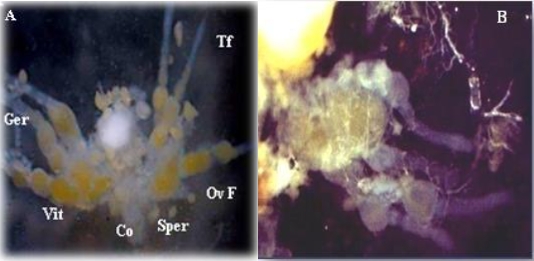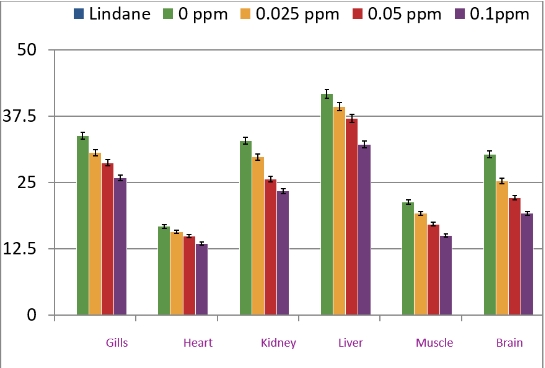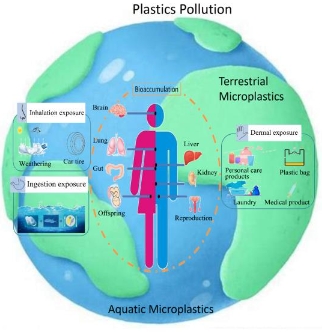Sources and toxicological effects of some heavy metals—A mini review
Abstract
Heavy metals play essential roles in biological activities as enzyme cofactors in trace amounts. However, their significance is overshadowed by potential harm in excess. Bio-accumulation, toxicity, non-biodegradability, and persistence are hallmarks that impact the environment and human health. Bio-accumulation is critical as metals accumulate in organisms, posing risks in ecosystems, especially in the food chain. This leads to elevated metal concentrations in the human food chain. Even at trace levels, heavy metals like lead, mercury, cadmium, chromium, and arsenic exhibit toxicity, causing various health issues, emphasizing the need to regulate exposure. Non-biodegradability distinguishes heavy metals; they persist in the environment, enhancing the risks associated with prolonged exposure and accumulation. Due to their recognized toxicity, heavy metals are a focus of research. Understanding sources, pathways, and effects is crucial for effective mitigation strategies. Researchers explore pollution control, improved industrial practices, and remediation techniques. Anthropogenic activities, such as industrialization, urbanization, waste disposal, and agricultural practices, release heavy metals into the environment. This contaminates air, water, and soil, contributing to environmental and health risks. The present paper discusses the sources and toxicological effects of various heavy metals.
References
[1]Jacob JM, Karthik C, Saratale RG, et al. Biological approaches to tackle heavy metal pollution: A survey of literature. Journal of Environmental Management. 2018; 217: 56-70. doi: 10.1016/j.jenvman.2018.03.077
[2]Bishop PL. Pollution prevention: Fundamentals and practice. Tsinghua University Press; 2002.
[3]Wang J, Chen C. Biosorption of heavy metals by Saccharomyces cerevisiae: A review. Biotechnology Advances. 2006; 24(5): 427-451. doi: 10.1016/j.biotechadv.2006.03.001
[4]Kortenkamp A, Casadevall M, Faux SP, et al. A Role for Molecular Oxygen in the Formation of DNA Damage during the Reduction of the Carcinogen Chromium(VI) by Glutathione. Archives of Biochemistry and Biophysics. 1996; 329(2): 199-207. doi: 10.1006/abbi.1996.0209
[5]Mitra S, Chakraborty AJ, Tareq AM, et al. Impact of heavy metals on the environment and human health: Novel therapeutic insights to counter the toxicity. Journal of King Saud University - Science. 2022; 34(3): 101865. doi: 10.1016/j.jksus.2022.101865
[6]Fred AO. A 50-year review on heavy metal pollution in the environment: Bivalves as bio-monitors. African Journal of Environmental Science and Technology. 2019; 13(6): 220-227. doi: 10.5897/ajest2018.2597
[7]Kumar R, Verma A, Shome A, et al. Impacts of Plastic Pollution on Ecosystem Services, Sustainable Development Goals, and Need to Focus on Circular Economy and Policy Interventions. Sustainability. 2021; 13(17): 9963. doi: 10.3390/su13179963
[8]Briffa J, Sinagra E, Blundell R. Heavy metal pollution in the environment and their toxicological effects on humans. Heliyon. 2020; 6(9): e04691. doi: 10.1016/j.heliyon.2020.e04691
[9]MacCarthy P, Klusman RW, Cowling SW, et al. Water Analysis. Analytical Chemistry. 1995; 67(12): 525-582. doi: 10.1021/ac00108a039
[10]Nriagu JO. Global inventory of natural and anthropogenic emissions of trace metals to the atmosphere. Nature. 1979; 279(5712): 409-411. doi: 10.1038/279409a0
[11]Sarker A, Masud MAA, Deepo DM, et al. Biological and green remediation of heavy metal contaminated water and soils: A state-of-the-art review. Chemosphere. 2023; 332: 138861. doi: 10.1016/j.chemosphere.2023.138861
[12]Volesky B. Removal and recovery of heavy metals by biosorption. Biosorption of heavy metals. CRC Press. 1990. pp. 7-44.
[13]Ahalya N, Kanamadi RD, Ramachandra TV. Biosorption of chromium (VI) from aqueous solutions by the husk of Bengal gram (Cicer arientinum). Electronic Journal of Biotechnology. 2005; 8(3): 258-264. doi: 10.2225/vol8-issue3-fulltext-10
[14]Balali-Mood M, Naseri K, Tahergorabi Z, et al. Toxic Mechanisms of Five Heavy Metals: Mercury, Lead, Chromium, Cadmium, and Arsenic. Frontiers in Pharmacology. 2021; 12. doi: 10.3389/fphar.2021.643972
[15]Tamele IJ, Vázquez Loureiro P. Lead, Mercury and Cadmium in Fish and Shellfish from the Indian Ocean and Red Sea (African Countries): Public Health Challenges. Journal of Marine Science and Engineering. 2020; 8(5): 344. doi: 10.3390/jmse8050344
[16]Kim EJ, Park S, Hong HJ, et al. Biosorption of chromium (Cr(III)/Cr(VI)) on the residual microalga Nannochloris oculata after lipid extraction for biodiesel production. Bioresource Technology. 2011; 102(24): 11155-11160. doi: 10.1016/j.biortech.2011.09.107
[17]Fosu-Mensah BY, Addae E, Yirenya-Tawiah D, et al. Heavy metals concentration and distribution in soils and vegetation at Korle Lagoon area in Accra, Ghana. Cogent Environmental Science. 2017; 3(1): 1405887. doi: 10.1080/23311843.2017.1405887
[18]Chileshe MN, Syampungani S, Festin ES, et al. Physico-chemical characteristics and heavy metal concentrations of copper mine wastes in Zambia: implications for pollution risk and restoration. Journal of Forestry Research. 2019; 31(4): 1283-1293. doi: 10.1007/s11676-019-00921-0
[19]Yang Q, Li Z, Lu X, et al. A review of soil heavy metal pollution from industrial and agricultural regions in China: Pollution and risk assessment. Science of The Total Environment. 2018; 642: 690-700. doi: 10.1016/j.scitotenv.2018.06.068
[20]Matta G, Gjyli L. Mercury, lead and arsenic: Impact on environment and human health. Journal of Chemical and Pharmaceutical Sciences. 2016; 9: 718-725.
[21]Rahman Z, Singh VP. The relative impact of toxic heavy metals (THMs) (arsenic (As), cadmium (Cd), chromium (Cr)(VI), mercury (Hg), and lead (Pb)) on the total environment: an overview. Environmental Monitoring and Assessment. 2019; 191(7). doi: 10.1007/s10661-019-7528-7
[22]Blewett TA, Leonard EM. Mechanisms of nickel toxicity to fish and invertebrates in marine and estuarine waters. Environmental Pollution. 2017; 223: 311-322. doi: 10.1016/j.envpol.2017.01.028
[23]Li C, Zhou K, Qin W, et al. A Review on Heavy Metals Contamination in Soil: Effects, Sources, and Remediation Techniques. Soil and Sediment Contamination: An International Journal. 2019; 28(4): 380-394. doi: 10.1080/15320383.2019.1592108
[24]Zhao FJ, Ma JF, Meharg AA, et al. Arsenic uptake and metabolism in plants. New Phytologist. 2008; 181(4): 777-794. doi: 10.1111/j.1469-8137.2008.02716.x
[25]Raab A, Ferreira K, Meharg AA, et al. Can arsenic-phytochelatin complex formation be used as an indicator for toxicity in Helianthus annuus? Journal of Experimental Botany. 2007; 58(6): 1333-1338. doi: 10.1093/jxb/erl300Ajmal M, Hussain Khan AH, Ahmad S, Ahmad A. Role of sawdust in the removal of copper (II) from industrial wastes. Water Research. 1998; 32(10): 3085-3091. doi: 10.1016/S0043-1354(98)00067-0
[26]Xu XY, McGrath SP, Zhao FJ. Rapid reduction of arsenate in the medium mediated by plant roots. New Phytologist. 2007; 176(3): 590-599. doi: 10.1111/j.1469-8137.2007.02195.x
[27]WHO. World Health Organization—Guidelines for Drinking water Quality, 4th ed. WHO; 2011. pp. 327-397
[28]Balakumar P, Kaur J. Arsenic Exposure and Cardiovascular Disorders: An Overview. Cardiovascular Toxicology. 2009; 9(4): 169-176. doi: 10.1007/s12012-009-9050-6
[29]Babel S, Kurniawan TA. Low-cost adsorbents for heavy metals uptake from contaminated water: A review. Journal of Hazardous Materials. 2003; 97(1-3): 219-243. doi: 10.1016/s0304-3894(02)00263-7
[30]Jarup L. Health effects of cadmium exposure - A review of the literature and a risk estimate. Scandinavian Journal of Work, Environment and Health. 1998; 24(Suppl) 1: 11-51.
[31]Volesky B. Detoxification of metal-bearing effluents: Biosorption for the next century. Hydrometallurgy. 2001; 59(2-3): 203-216. doi: 10.1016/S0304-386X(00)00160-2
[32]Zouboulis AI, Loukidou MX, Matis KA. Biosorption of toxic metals from aqueous solutions by bacteria strains isolated from metalpolluted soils. Process Biochemistry. 2004; 39(8): 909-916. doi: 10.1016/S0032-9592(03)00200-0
[33]Volesky B, Naja G. Biosorption: Application strategies. In: Proceedings of the 16th International Biohydrometallurgy Symposium; 25-29 September 2005; Cape Town, South Africa. pp. 531-542
[34]Chen JM, Hao OJ. Microbial Chromium (VI) Reduction. Critical Reviews in Environmental Science and Technology. 1998; 28(3): 219-251. doi: 10.1080/10643389891254214
[35]Low KS, Lee CK, Liew SC. Soprtion of cadmium and lead from aqueous solutions by spent grain. Process Biochemistry. 2000; 36(1-2): 59-64. doi: 10.1016/S0032-9592(00)00177-1
[36]Singh KK, Singh AK, Hasan SH. Low cost bio-sorbent “wheat bran” for the removal of cadmium from wastewater: Kinetic and equilibrium studies. Bioresource Technology. 2006; 97(8): 994-1001. doi: 10.1016/j.biortech.2005.04.043
[37]Pinto A, Mota A, Devarennes A, et al. Influence of organic matter on the uptake of cadmium, zinc, copper and iron by sorghum plants. Science of The Total Environment. 2004; 326(1-3): 239-247. doi: 10.1016/j.scitotenv.2004.01.004
[38]Rai V, Khatoon S, Bisht SS, Mehrotra S. Effect of cadmium on growth, ultramorphology of leaf and secondary metabolites of Phyllanthus amarus Schum and Thonn. Chemosphere. 2005; 61(11): 1644-1650. doi: 10.1016/j.chemosphere.2005.04.052
[39]Cieslak-Golonka M. Toxic and mutagenic effects of chromium (VI). Polyhedron. 1995; 15(21): 3667-3689.
[40]Vinodhini V, Das N. Relevant approach to assess the performance of sawdust as adsorbent of chromium (VI) ions from aqueous solutions. International Journal of Environmental Science & Technology. 2009; 7(1): 85-92. doi: 10.1007/bf03326120
[41]De Filippis LF, Pallaghy CK. Heavy metals: Sources and biological effects. In: Rai LC, Gaur JP, Soeder CJ (editors). Advances in Limnology Series, Algae and Water Pollution. E. Scheizerbartsche Press; 1994. pp. 31-77.
[42]Dupont L, Guillon E. Removal of Hexavalent Chromium with a Lignocellulosic Substrate Extracted from Wheat Bran. Environmental Science & Technology. 2003; 37(18): 4235-4241. doi: 10.1021/es0342345
[43]Eastmond DA, MacGregor JT, Slesinski RS. Trivalent Chromium: Assessing the Genotoxic Risk of an Essential Trace Element and Widely Used Human and Animal Nutritional Supplement. Critical Reviews in Toxicology. 2008; 38(3): 173-190. doi: 10.1080/10408440701845401
[44]Singh KK, Hasan SH, Talat M, et al. Removal of Cr (VI) from aqueous solutions using wheat bran. Chemical Engineering Journal. 2009; 151(1-3): 113-121. doi: 10.1016/j.cej.2009.02.003
[45]Guo W, Chen R, Liu Y, et al. Preparation of ion-imprinted mesoporous silica SBA-15 functionalized with triglycine for selective adsorption of Co(II). Colloids and Surfaces A: Physicochemical and Engineering Aspects. 2013; 436: 693-703. doi: 10.1016/j.colsurfa.2013.08.011
[46]Friberg L. Handbook on the Toxicology of Metals. Elsevier Science Publishers; 1986.
[47]Yao ZY, Qi JH, Wang LH. Equilibrium, kinetic and thermodynamic studies on the biosorption of Cu(II) onto chestnut shell. Journal of Hazardous Materials. 2010; 174(1-3): 137-143. doi: 10.1016/j.jhazmat.2009.09.027
[48]Jaman H, Chakraborty D, Saha P. A Study of the Thermodynamics and Kinetics of Copper Adsorption Using Chemically Modified Rice Husk. CLEAN - Soil, Air, Water. 2009; 37(9): 704-711. doi: 10.1002/clen.200900138
[49]Davis TA, Volesky B, Vieira RHSF. Sargassum seaweed as biosorbent for heavy metals. Water Research. 2000; 34(17): 4270-4278. doi: 10.1016/S0043-1354(00)00177-9
[50]Papandreou A, Stournaras CJ, Panias D. Copper and cadmium adsorption on pellets made from fired coal fly ash. Journal of Hazardous Materials. 2007; 148(3): 538-547. doi: 10.1016/j.jhazmat.2007.03.020
[51]Tunali Akar S, Arslan S, Alp T, et al. Biosorption potential of the waste biomaterial obtained from Cucumis melo for the removal of Pb2+ ions from aqueous media: Equilibrium, kinetic, thermodynamic and mechanism analysis. Chemical Engineering Journal. 2012; 185-186: 82-90. doi: 10.1016/j.cej.2012.01.032
[52]World Health Organization. Available online: http://www.who.int/mediacentre/factsheets/Fs210/en (accessed on 20 January 2024).
[53]Gaballah I, Kilbertus G. Recovery of heavy metal ions through decontamination of synthetic solutions and industrial effluents using modified barks. Journal of Geochemical Exploration. 1998; 62(1-3): 241-286. doi: 10.1016/S0375-6742(97)00068-X
[54]El-Shafey EI. Removal of Zn(II) and Hg(II) from aqueous solution on a carbonaceous sorbent chemically prepared from rice husk. Journal of Hazardous Materials. 2010; 175(1-3): 319-327. doi: 10.1016/j.jhazmat.2009.10.006Alomá I, Martín-Lara MA, Rodríguez IL, et al. Removal of nickel (II) ions from aqueous solutions by biosorption on sugarcane bagasse. Journal of the Taiwan Institute of Chemical Engineers. 2012; 43(2): 275-281. doi: 10.1016/j.jtice.2011.10.011
[55]Boening DW. Ecological effects, transport, and fate of mercury: A general review. Chemosphere. 2000; 40(12): 1335-1351. doi: 10.1016/s0045-6535(99)00283-0
[56]Manohar DM, Krishnan KA, Anirudhan TS. Removal of mercury (II). Water Research. 2002; 36(6): 1609-1619. doi: 10.1016/s0043-1354(01)00362-1
[57]Morel FMM, Kraepiel AML, Amyot M. THE CHEMICAL CYCLE AND BIOACCUMULATION OF MERCURY. Annual Review of Ecology and Systematics. 1998; 29(1): 543-566. doi: 10.1146/annurev.ecolsys.29.1.543
[58]Risher JF, Amler SN. Mercury exposure: Evaluation and intervention the inappropriate use of chelating agents in the diagnosis and treatment of putative mercury poisoning. Neurotoxicology. 2005; 26(4): 691-699. doi: 10.1016/j.neuro.2005.05.004
[59]Clifton JC. Mercury Exposure and Public Health. Pediatric Clinics of North America. 2007; 54(2): 237.e1-237.e45. doi: 10.1016/j.pcl.2007.02.005
[60]Akhtar N. Removal and recovery of nickel (II) from aqueous solution by loofa sponge-immobilized biomass of Chlorella sorokiniana: characterization studies. Journal of Hazardous Materials. 2004; 108(1-2): 85-94. doi: 10.1016/j.jhazmat.2004.01.002
[61]Farooq U, Kozinski JA, Khan MA, et al. Biosorption of heavy metal ions using wheat based biosorbents - A review of the recent literature. Bioresource Technology. 2010; 101(14): 5043-5053. doi: 10.1016/j.biortech.2010.02.030
[62]Gupta VK, Rastogi A, Nayak A. Biosorption of nickel onto treated alga (Oedogonium hatei): Application of isotherm and kinetic models. Journal of Colloid and Interface Science. 2010; 342(2): 533-539. doi: 10.1016/j.jcis.2009.10.074
[63]Underwood EJ. Trace Elements in Human and Animal Nutrition, 4th ed. Academic Press; 1977. p. 545.
[64]Seaman JC, Bertsch PM, Schwallie L. In Situ Cr(VI) Reduction within Coarse-Textured, Oxide-Coated Soil and Aquifer Systems Using Fe(II) Solutions. Environmental Science & Technology. 1999; 33(6): 938-944. doi: 10.1021/es980546
[65]Tiravanti G, Petruzzelli D, Passino R. Pretreatment of tannery wastewaters by an ion exchange process for Cr(III) removal and recovery. Water Science and Technology. 1997; 36(2-3): 197-207. doi: 10.2166/wst.1997.0518
[66]Kongsricharoern N, Polprasert C. Chromium removal by a bipolar electro-chemical precipitation process. Water Science and Technology. 1996; 34(9): 109-116. doi: 10.2166/wst.1996.0189
[67]Puranik PR, Paknikar KM. Biosorption of Lead, Cadmium, and Zinc by Citrobacter Strain MCM B-181: Characterization Studies. Biotechnology Progress. 1999; 15(2): 228-237. doi: 10.1021/bp990002r
[68]Basso MC, Cerrella EG, Cukierman AL. Lignocellulosic Materials as Potential Biosorbents of Trace Toxic Metals from Wastewater. Industrial & Engineering Chemistry Research. 2002; 41(15): 3580-3585. doi: 10.1021/ie020023h
[69]Volesky B, Holan ZR. Biosorption of Heavy Metals. Biotechnology Progress. 1995; 11(3): 235-250. doi: 10.1021/bp00033a001
[70]Kratochvil D, Volesky B. Advances in the biosorption of heavy metals. Trends in Biotechnology. 1998; 16(7): 291-300. doi: 10.1016/S0167-7799(98)01218-9
[71]Kapoor A, Viraraghavan T. Fungal biosorption- an alternative treatment option for heavy metal bearing wastewater: A review. Bioresource Technology. 1995; 53: 195-206.
Copyright (c) 2024 V. N. Meena Devi

This work is licensed under a Creative Commons Attribution 4.0 International License.








